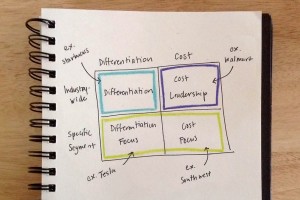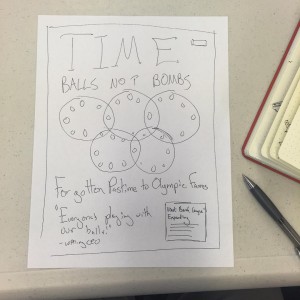Dave Holston’s Show Me, Don’t Tell Me workshop provided designers with tools to spark creativity and engage clients in fun, collaborative activities merging design expertise with business skills.
“You are already a creative thinker, now become a strategic partner by driving the strategy and engaging your clients on a deeper level with the tools not just the aesthetics.”
Starting the workshop, Dave encouraged attendees to form pairs and join in a fun, collaborative exercise. A person in each pair began drawing a part of face, one element at a time, switching with their partner to add each subsequent element until each pair completed, and named, their face. The exercise can serve as an ice-breaker with clients, encouraging openness and building communication channels for a true collaborative session.
The workshop demonstrated that process drives the outcome. As designers, we need to understand a problem to be able to solve it, and think beyond just making it look good. Most importantly, Dave stressed, is to gauge if a solution is successful in the marketplace. Design needs to be looked at in context, be it on the shelf, in publications, on the web, on mobile devices, and/or social media.
Here are some examples of further exercises that Dave shared through the course of the workshop:
Michael Porter’s Generic Strategies —-
Purpose:
Analyzing competitive advantages
Focus:
- Cost: Only one company can be the cheapest, does this apply?
- Focus: Does the company offer specialized products/services and or focus on a niche market?
- Differentiation: Does the company provide a unique audience value through performance, quality or prestige?
Process:
Discuss with your client where their company falls within this chart and why. Determining which of these strategies they employ will help you better understand the client and their business.
Benefit:
The benefit of this tool is that you’ll come away with an understanding of the business strategy: Who is the audience? Who is the competition?
Vision Exercise: Drawing the future state —-

Purpose:
Allows the client to project where they want to invest their energy based on their future goals.
Focus:
Aspirations/Goals
Process:
Years from now, what will the company/product be known for? Imagine a TIME magazine cover with the product and a headline about the company. Use sidebars for facts about the company and quotes – “What people are saying”. Show images that depict the future of the product.
Benefit:
This tool allows you to help client think about the ideal future state for the company. It encourages people to think big.
This exercise is based on the Grove Consultants International’s Cover Story Vision.
(Nick, do you have an image of your group Cover exercise?)
Understand the Audience —-

Purpose:
Addressing the behaviors of different types of customers
Focus:
4 Personality Types
- Spontaneous (quick/emotional) looks for confirmation
- Competitive (quick/logical) looks for your competitive advantages
- Humanist (deliberate/emotional) seeks relationship with the company she’s buying from
- Methodical (deliberate/logical) looks for details and wants to know exactly how you can solve their problem
Process:
- Build a persona exercise:
- Photo: What do they look like?
- Name: What do we call them?
- Personality type: Which of the four personality types are they?
- Description: What is the problem they are trying to solve?
- Personality profile: Are they emotional or logical? Do they make quick or deliberate decision? What do they need from the brand? How do they want the brand information presented? How can the brand support their decision making process?
Benefit:
Better understand the mindset, personality, and goals of users and how the product fits with and responds to each.
Totemics, a metaphor-based technique —-
Purpose:
Collaborating with the client to define brand characteristics they’re looking for by matching the images of existing objects to the desired attributes.
Focus:
- Define context and vocabulary
- Understand perceptions
- Create visual representations
Process:
Coming into this exercise, the problem should already be defined and clearly understood. First, discuss adjectives that describe the feeling of the brand with your client – what is its character, its style? Then, use pictures of objects, such as cars, furniture, architecture or animals, to seek out a clear vision for the design. Decide with your client which feel right for the brand, and which do not.
Benefit:
This exercise allows you to define a visual direction. You will come away with a mood board that can be used to create the brand look and feel.
Totemics method was developed by Angela Dumas.
Dave Holston has worked in the fields of public affairs, marketing, advertising, communication planning, and design management for leading organizations.
To learn more about how to work strategically check out his book The Strategic Designer and Show Me, Don’t Tell Me.
Lead photo provided by Thank you, Enjoy. Recap notes by Lia Scardamaglia.